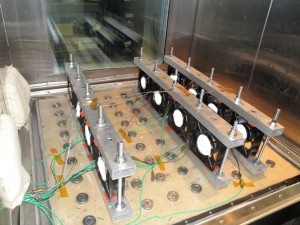A customer approached DES looking to find an accelerated test solution for an AC powered cooling fan used in one of their products. The product had been established in the marketplace and the company was now looking for ways to reduce cost by looking at different cooling fan suppliers. Most fans, however, have a mean life rated for over 20,000 hours, so a typical accelerated life test would require a significant amount of time and money.
DES Solution
Performing a quantitative accelerated life test on cooling fans presents challenges because they have such a long lifespan. Reasonably speaking, the shortest quantitative solution for determining the lifespan of a fan could take as long as a couple months. DES proposed a qualitative solution, a Rapid HALT. A Rapid HALT (Highly Accelerated Life Test) is designed to apply a variety of stresses, concurrently, to a product in order to significantly time compress a product’s lifespan. A typical Rapid HALT lasts only one day which is extremely convenient for companies that need results quickly.
Results
A sample size of 3 cooling fans were tested for 4 different fan suppliers. We will refer to these suppliers as Supplier A, B, C and D. All 12 fans were placed in the chamber together and a Rapid HALT was conducted. None of the four suppliers survived testing without some issues but the results were still differentiating. Supplier A had no electrical issues in any of its samples but the fan blades on all 3 samples vibrated off the armature. Fans of Supplier B, all experienced sputtering of the fan blade and eventually saw two of its fans current levels drop to 0. By the time testing was completed, none of the fans were functioning. Supplier C fared slightly better than A and B. One of Supplier C’s fans lost current at the most extreme step and never recovered. The other two however, experienced fan blade sputtering but were functioning normally upon final inspection. Supplier D performed the best out of the four suppliers and thus would be considered the most durable of the suppliers tested. Only one of the fans experienced any issues, in which it lost current at the most extreme step. Upon final inspection all of the fans were functioning normally.
There are other factors to consider such as price and accessibility but these results were able to successfully assist our customer in differentiating between the reliability of the four fan suppliers. While a HALT is qualitative and will not produce an actual estimated fan lifetime, it is a great comparison tool to evaluate the reliability of different suppliers faster and less expensive than traditional testing techniques.
